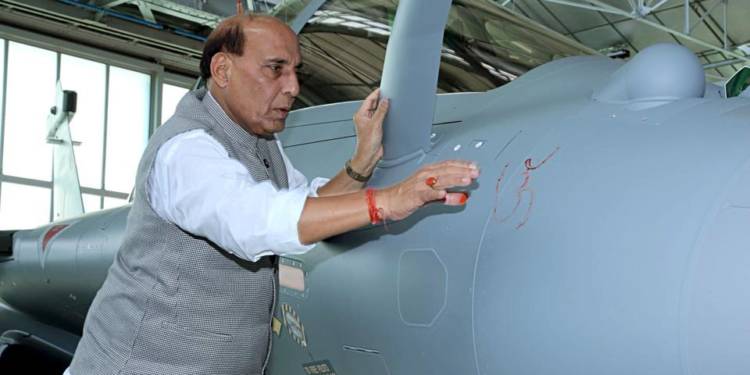2019 was a year of many things. It marked the start of the second term of the Narendra Modi government who returned with a historic mandate. This year also saw India’s national security take precedence as it assumed a centre stage thanks to Modi government’s relentless push to enhance India’s security apparatus. It is safe to say that 2019 was the year of Indian defence and national security.
The dastardly attack of Pulwama made the blood boil of every Indian. While Manmohan Singh refused to allow the Indian Army to strike back at Pakistan post 26/11, Prime Minister Modi gave a free hand to the Armed Forces to avenge the death of their brothers and hence, the Balakot Airstrike took place. “It was over in 90 seconds; we released the weapon and we turned back,” said one of the Mirage 2000 fighter pilots, asking not to be named. In first such accounts of the Balakot airstrikes, pilots reveal to the Hindustan Times, details of the operation which was carried out in the wee hours of 26th of February. Tensions between India and Pakistan rose to dangerous levels after the deadly terror attack by the Pakistan based terror group, Jaish-e-Mohammed (literally “The Army of Muhammad”) in the Indian state of Jammu and Kashmir which killed more than 40 soldiers of the Central Reserve Police Force. After the attack, India promptly assessed the situation and in a pre-emptive anti-terror airstrike, the Indian Air Force destroyed a major terror camp in Balakot, Pakistan, in which, according to intelligence reports, around 300 terrorists were killed. The Indian forces successfully entered Pakistani territory and destroyed terror camps without being detected by Pakistan’s air defence radar systems.
The Balakot airstrike had a cascading effect on Pakistan as it significantly reduced its adventurism on the Line of Control. The number of ceasefire violations dropped from 267 in March to just 181 in June. However, other than the decline in frequency, a major shift can be seen in parties desisting from any “calibre escalation” or incremental use of weapons of a higher calibre to respond to ceasefire violations. The Indian government also stated that the first six months of 2019 situation in the state of Jammu & Kashmir has seen improvement with 28% decline in terrorist acts, infiltration reduced by 43%, local recruitment declined by 40% and neutralisation of terrorists increased by 22%.
In a historic boost to the firepower of the Indian Air Force, the first four AH-64E Apache attack helicopters had been delivered to India in July and inducted in September. The induction of Apache helicopters will come as a matter of huge relief for the Indian Air Force, which currently uses decades-old, Russian made Mi-35 and Mi-25 attack helicopters. The current assets have far outlived their utility and the IAF was in dire need of world-class attack helicopters. Currently, the IAF also Rudra attack helicopters, developed out of the indigenous Advanced Light Helicopter ‘Dhruv’. Apache helicopters are undoubtedly the leading helicopters as far as attack helicopters around the world are concerned. These helicopters not only have impressive capabilities but have also seen action proving its worth. Apache helicopters are the primary attack helicopters of multiple nations like Israel, United Arab Emirates and others along with the United States. Apache helicopters are known for their trustworthiness and have proved very helpful in many operations conducted by the US Army around the globe. The primary attack helicopters have great power and can be used both day and night. They will increase the capacity of the Indian Defence Forces to attack and conduct operations in a given area. Along with the Apache helicopters, the US State Department had also agreed last year to the sale of four AN/APG-78 Fire Control Radars, 180 AGM-114L-3 Hellfire Longbow missiles, 90 AGM-114R-3 Hellfire II missiles, 200 Stinger Block I-92H missiles, Embedded GPS Inertial Navigation Systems, 30mm cannons, transponders, simulators, training equipment to India.
In February India’s defence capabilities were further boosted as the first four of the fifteen Chinook CH-47F (I) heavy-lift helicopters that were ordered by the Indian Air Force from the United States, in 2015 arrived in India. The helicopters were handed over to the Indian Air Force in Philadelphia. The Chinooks arrived at the Mundra port in Gujarat. Boeing announced the arrival of the helicopters and stated that they will be ferried to Chandigarh and they were formally inducted in the IAF in March. Boeing in a statement said, “the ahead-of-schedule arrival of the Chinooks validates Boeing’s commitment to delivering on its promise of modernising India’s defence forces.” The company added, “through its current partnerships with Indian Air Force and Indian Navy, Boeing has ensured a high rate of mission readiness and increased operational capabilities.” The Chinook helicopters have come as a matter of huge relief for India. These helicopters have a payload capacity of a mind-boggling 10 tonnes and they would assist the IAF in its heavy-lifting capabilities. It must be kept in mind that before Chinooks, this task was undertaken by the Mi-26 choppers. However, only one of the four such Mi-26 choppers that India had is fit for service now. Therefore, the induction of the four out of fifteen Chinook helicopters in the IAF will solve the issue of heavy-lifting capabilities to a great extent. The government had signed a deal with the United States in 2015, for the delivery of 15 Chinook helicopters, with an option of another four available on demand, apart from 22 AH 64 Apache attack helicopters that would be based elsewhere.
The Chinook helicopters are famous for their impressive payload capacity and will make the job of the Indian Air Force a lot more easier when it comes to lifting artillery, vehicles and other heavy engineering equipment. It will also prove to be a game-changer in case of covert operations like the historical surgical strikes of 2016, as well as facilitate supplies to mountainous sectors in the North and North-East. This deal and the arrival of the helicopters ahead of schedule evidence the firm commitment of the Modi government as far as the strengthening of the Indian defence forces is concerned.
Despite the slanderous campaign led by Rahul Gandhi led Congress against the Rafale Jets, India finally received the first Rafale jet manufactured for the Indian Air Force. This marked the culmination of a long-fought battle in order to bring a sophisticated fighter jet-like Rafale to India. It all began in September 2016, when India signed a deal with the French government and Dassault Aviation to acquire 36 Rafale fighter jets for over Euro 7.8 billion in order to counter the fall of combat squadrons and meet urgent requirements on the eastern and western fronts. The deal was signed in the presence of the then Defence Minister [now deceased], Manohar Parrikar, and ended an unnecessary delay in upgrading the IAF squadrons initiated under the watch of the then UPA government. However, unable to bear the fact that someone could clear an important deal like the Rafale one without any ‘cuts’, the Congress party cried foul, accusing BJP led NDA, Dassault Aviation and the French government of foul play, despite their continuous clarifications issued time and again denying the same. When asked about why they delayed the deal themselves, one of the Congress politicians, then the Defence Minister under the UPA government had this to say, “I delayed the deal to protect the national interest. The Prime Minister sacrificed our national interests.” The Supreme Court also slammed the Rafale petitioners which forced Rahul Gandhi to tender an apology to Prime Minister Modi.
The Indian Army in order to carry out counter-terror operations in Jammu and Kashmir and check any Pakistan misadventures across the LoC has started inducting its newly acquired American SiG Sauer assault rifles in operations. Also, the Indian Army has started getting supplies of ammunition for its sniper rifles as more than 21 Lakh rounds have been ordered from vendors. “The first lot of 10,000 SiG 716 assault rifles has arrived in India and has been sent to the Northern Command,” top Indian Army sources told ANI. The induction of these new assault rifles with the troops in operation will help them to operate more effectively in engagements with the terrorists in Pakistan and PoK. India had signed an over Rs 700 crore contract to equip the Indian Army with 72,400 new assault rifles. The Indian Army will also receive a major boost with the induction of more than 7 lakh AK-203 assault rifles which are going to be produced in the joint venture between India and Russia.
This year, India made a big leap in its space technology capabilities and became only the fourth nation to boast of Anti Satellite weapons technology. India already has a conventional military superiority over Pakistan and the ASAT capability has made the power asymmetry between the two countries in India’s favour, significantly. As such, India’s ASAT capability must be seen as a counter to China’s, a nation in possession of the capability. The testing of ASAT weapons technology by India is not a show of muscle power. It is a realisation of the future needs of national security and India has successfully kept pace with the next-generation technology of warfare.
2019 was without a doubt the year where India’s defence mechanisms and national security were given principal focus as the Narendra Modi government will stop at nothing to safeguard India and its interests.































